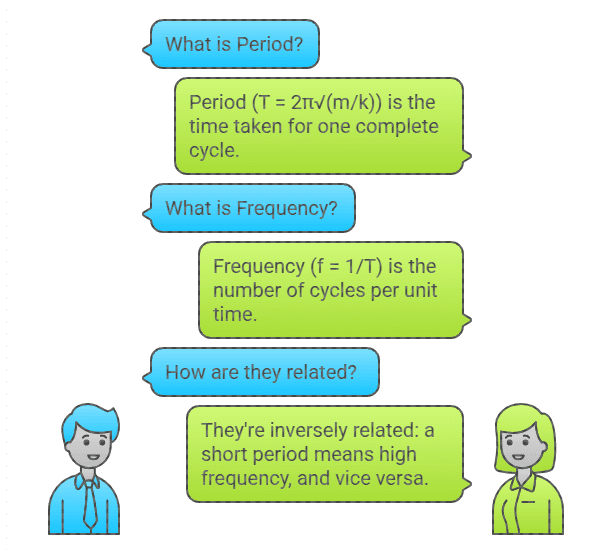Mnemonic: Oscillations | Physics Class 11 - NEET PDF Download
| Table of contents |

|
| 1. Simple Harmonic Motion (SHM) |

|
| 2. Period and Frequency of SHM |

|
| 3. Equation of Motion for SHM |

|
| 4. Damped Oscillations |

|
1. Simple Harmonic Motion (SHM)
Mnemonic: "Simple Harmonics Sound Perfect"
Simple – Simple Harmonic Motion (SHM)
Harmonics – Harmonic Oscillator (an object that undergoes SHM)
Sound – Sine wave (motion is sinusoidal)
Perfect – Period of oscillation (T = 2π√(m/k))
SHM is a type of oscillatory motion where the restoring force is directly proportional to displacement and acts opposite to it. The displacement follows a sinusoidal pattern, and the time period is determined by the system's mass and stiffness (spring constant).
2. Period and Frequency of SHM
Mnemonic: "Perfect Timing and Fast Oscillations"
Perfect – Period (T = 2π√(m/k))
Timing – Time taken for one complete cycle
Fast – Frequency (f = 1/T)
Oscillations – Number of cycles per unit time
The period is the duration of one full oscillation, while the frequency is how many oscillations occur per second. They're inversely related: a short period means high frequency, and vice versa.

3. Equation of Motion for SHM
Mnemonic: "Sinusoidal Motion Always Follows"
Sinusoidal – SHM displacement follows sine/cosine wave
Motion – x(t) = A cos(ωt + φ)
Always – Amplitude (A) is constant
Follows – Angular frequency (ω = √(k/m))
The motion of an SHM system can be modeled mathematically with sinusoidal functions. The amplitude defines maximum displacement, and angular frequency depends on the physical properties of the system.
4. Damped Oscillations
Mnemonic: "Dampening Slowly Reduces Energy"
Dampening – Resistance opposes motion (friction, air drag)
Slowly – Gradual amplitude reduction over time
Reduces – Energy decreases continuously
Energy – Exponential decay of motion
Damped oscillations happen in non-ideal conditions where energy is lost due to resistive forces. This results in a decrease in amplitude over time, leading to eventual rest.
|
96 videos|367 docs|98 tests
|
FAQs on Mnemonic: Oscillations - Physics Class 11 - NEET
| 1. What is Simple Harmonic Motion (SHM) and its characteristics? |  |
| 2. How do you calculate the time period of a simple pendulum? |  |
| 3. What are the components of a spring-mass system in oscillations? |  |
| 4. How is energy distributed in Simple Harmonic Motion (SHM)? |  |
| 5. What are damped oscillations and how do they differ from forced oscillations? |  |















